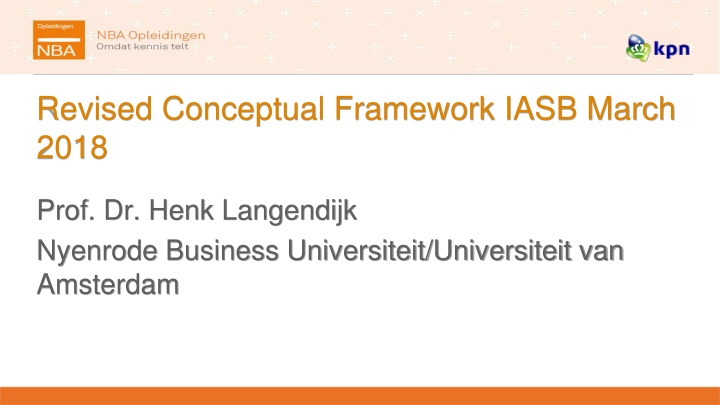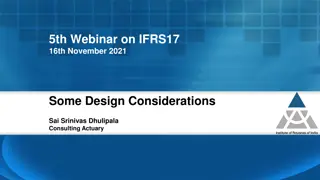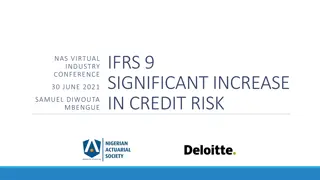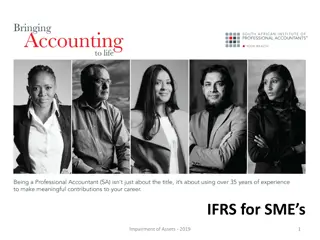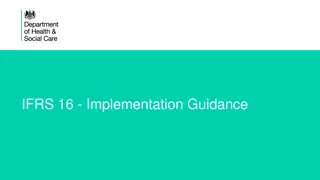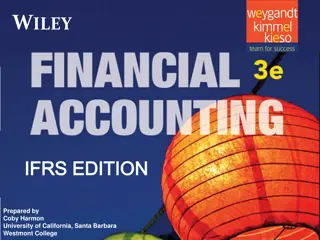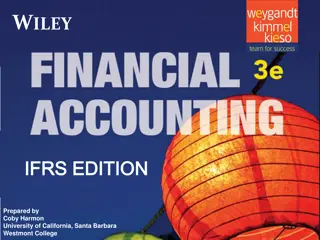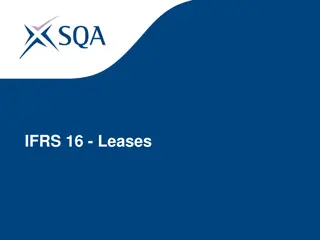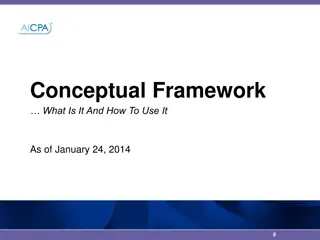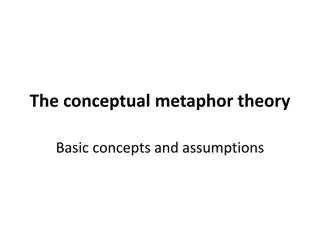Revised Conceptual Framework for IFRS Standards
The Revised Conceptual Framework for IFRS Standards by Prof. Dr. Henk Langendijk provides concepts and guidance to develop consistent financial information useful to investors, lenders, and creditors. It assists in establishing accounting policies and understanding IFRS Standards, with a focus on financial reporting objectives and qualitative characteristics of financial information.
Download Presentation

Please find below an Image/Link to download the presentation.
The content on the website is provided AS IS for your information and personal use only. It may not be sold, licensed, or shared on other websites without obtaining consent from the author.If you encounter any issues during the download, it is possible that the publisher has removed the file from their server.
You are allowed to download the files provided on this website for personal or commercial use, subject to the condition that they are used lawfully. All files are the property of their respective owners.
The content on the website is provided AS IS for your information and personal use only. It may not be sold, licensed, or shared on other websites without obtaining consent from the author.
E N D
Presentation Transcript
Revised Conceptual Framework IASB March 2018 Prof. Dr. Henk Langendijk Nyenrode Business Universiteit/Universiteit van Amsterdam
Purpose Assist the Board to develop IFRS Standards (Standards) based on consistent concepts, resulting in financial information that is useful to investors, lenders and other creditors Assist preparers of financial reports to develop consistent accounting policies for transactions or other events when no Standard applies or a Standard allows a choice of accounting policies Assist all parties to understand and interpret Standards
Status and Effective date Status Provides concepts and guidance that underpin the decisions the Board makes when developing Standards Not a Standard Does not override any Standard or any requirement in a Standard Effective date Immediately for the Board and the IFRS Interpretations Committee Annual periods beginning on or after 1 January 2020 for preparers who develop an accounting policy based on the Conceptual Framework
Chapter 1: The objective of financial reporting To provide financial information that is useful to users in making decisions relating to providing resources to the entity Users decisions involve decisions about buying, selling or holding equity or debt instruments, providing or settling loans and other forms of credit, voting, or otherwise influencing management s actions To make these decisions, users assess prospects for future net cash inflows to the entity and management s stewardship of the entity s economic resources INFO needed about: Entity s economic resources, claims against the entity and changes in those resources and claims and how efficiently and effectively management has discharged its responsibilities to use the entity s economic resources
Chapter 2 Qualitative characteristics of useful financial information Relevance and Faithful representation are the fundamental qualitative characteristics of useful financial info, and the guiding concepts of the revised CF. Relevance: Info is relevant if it is capable of making a difference to decisions of users Financial information is capable of making a difference in decisions if it has predictive value or confirmatory value. Faithful representation: Info must faithfully represent the substance of what it purports to represent Faithful representation is, to the maximum extent possible, complete, neutral and free from error Faithful representation is affected by level of measurement uncertainty
Qualitative characteristics that enhance usefulness of information and Cost constraint Comparability Verifiability Timeliness Understandability (but they cannot make non-useful information useful) Cost constraint: Benefit of providing the info needs to justify the cost of providing and using info
Prudence and Measurement uncertainty Prudence: Neutrality is supported by the exercise of prudence. Prudence is the exercise of caution when making judgements under conditions of uncertainty. Prudence does not allow for overstatement or understatement of assets, liabilities, income or expenses. Asymmetry of losses and profits!! Measurement uncertainty: Measurement uncertainty does not prevent info from being useful. However, in some cases the most relevant information may have such a high level of measurement uncertainty that most useful info is info that is slightly less relevant but is subject to lower measurement uncertainty.
Chapter 3 Financial statements and the reporting entity (new) Reporting entity: An entity that is required, or chooses, to prepare financial statements Not necessarily a legal entity could be a portion of an entity or comprise more than one entity Financial statements: a particular form of financial reports that provide info about reporting entity s assets, liabilities, equity, income and expenses. Determining the appropriate boundary of a reporting entity can be difficult if, for example, the entity is not a legal entity. Relevance and faithfully represents what it purports to represent for users!!
Three types of financial statements 1. Consolidated financial statements: Info about assets, liabilities, equity, income and expenses of both the parent and its subsidiaries as a single reporting entity 2. Unconsolidated financial statements: Info about assets, liabilities, equity, income and expenses of the parent only. 3. Combined financial statements: Info about assets, liabilities, equity, income and expenses of two or more entities that are not all linked by a parent- subsidiary relationship
Chapter 4 Elements of financial statements Previous definition of an asset: A resource controlled by the entity as a result of past events and from which future economic benefits are expected to flow to the entity Revised definition of an asset: A present economic resource controlled by the entity as a result of past events. An economic resource is a right that has the potential to produce economic benefits Main changes definition of an asset: Separate definition of an economic resource to clarify that an asset is the economic resource, not the ultimate inflow of economic benefits Deletion of expected flow it does not need to be certain, or even likely, that economic benefits will arise A low probability of economic benefits might affect recognition decisions and the measurement of the asset
Definition Liability Previous definition of a liability: A present obligation of the entity arising from past events, the settlement of which is expected to result in an outflow from the entity of resources embodying economic benefits Revised definition of a liability: A present obligation of the entity to transfer an economic resource as a result of past events. An obligation is a duty or responsibility that the entity has no practical ability to avoid Main changes definition of a liability: Separate definition of an economic resource to clarify that a liability is the obligation to transfer the economic resource, not the ultimate outflow of economic benefits Deletion of expected flow with the same implications as set out above for an asset Introduction of the no practical ability to avoid criterion to definition of obligation
No practical ability to avoid criterion liability No practical ability to avoid criterion is applied in following circumstances: (a) if a duty or responsibility arises from the entity s customary practices, published policies or specific statements the entity has an obligation if it has no practical ability to act in a manner inconsistent with those practices, policies or statements (constructive obligation). (b) if a duty or responsibility is conditional on a particular future action that the entity itself may take the entity has an obligation if it has no practical ability to avoid taking that action
Chapter 4 Unit of account Unit of account: right(s) or obligation(s), or group of rights and obligations, to which recognition criteria and measurement concepts are applied Selecting the unit of account: Relevance: Unit of account is selected to provide relevant info about the asset or liability and any related income and expenses Faithful representation: Unit of account is selected to provide a faithful representation of the substance of the transaction or other event from which the asset, liability and any related income or expenses have arisen
Chapter 5 Recognition and derecognition (new) Recognition: Process of capturing for inclusion in the statement of financial position or the statement(s) of financial performance an item that meets the definition of an asset, a liability, equity, income or expenses Recognition is appropriate if it results in both relevant info about assets, liabilities, equity, income and expenses and a faithful representation of those items, because the aim is to provide info useful to investors, lenders and other creditors
Recognition criteria Relevance: Whether recognition of an item results in relevant info may be affected by, for example: low probability of a flow of economic benefits and existence uncertainty Faithful representation: Whether recognition of an item results in a faithful representation may be affected by, for example: measurement uncertainty, recognition inconsistency (accounting mismatch) and presentation and disclosure Cost constrains recognition decisions, just as it constrains other financial reporting decisions
Derecognition (new) Derecognition: removal of all or part of a recognised asset or liability from an entity s statement of financial position Derecognition normally occurs: For an asset: when the entity loses control of all or part of the recognised asset For a liability: when the entity no longer has a present obligation for all or part of the recognised liability Derecognition aims to faithfully represent both: any assets and liabilities retained after the transaction that led to the derecognition change in the entity s assets and liabilities as a result of that transaction Distinction between Transferred component and Retained component
Chapter 6 Measurement (much more guidance) A. Historical cost (HC) measurement bases: HC provides info derived, at least in part, from price of the transaction or other event that gave rise to the item being measured HC of assets is reduced if they become impaired and HC of liabilities is increased if they become onerous One way to apply a HC measurement basis to financial assets and financial liabilities is to measure them at amortised cost (AC)
B. Current value (CV) measurement bases Current value provides info updated to reflect conditions at the measurement date B1: Fair value: The price that would be received to sell an asset, or paid to transfer a liability, in an orderly transaction between market participants at the measurement date = an exit value Reflects market participants current expectations about the amount, timing and uncertainty of future cash flows. B2: Value in use (for assets) B2: Fulfilment value (for liabilities): Reflects entity-specific current expectations about the amount, timing and uncertainty of future cash flows B3: Current cost Reflects the current amount that would be paid to acquire an equivalent asset and received to take on an equivalent liability = an entry value Effect changing prices = holding gain/loss
Factors to consider in selecting a measurement basis (continued) Relevance of info provided by a measurement basis is affected by: 1. Characteristics of the asset or liability the variability of cash flows sensitivity of the value to market factors or other risks e.g., amortised cost cannot provide relevant info about a derivative 2. Contribution to future cash flows whether cash flows are produced directly or indirectly in combination with other economic resources the nature of the entity s business activities e.g., if assets are used in combination to produce goods or services, historical cost can provide relevant information about margins achieved in a period
Factors to consider in selecting a measurement basis (continued) Whether a measurement basis can provide a faithful representation is affected by: 1. Measurement inconsistency If financial statements contain measurement inconsistencies (accounting mismatch), those financial statements may not faithfully represent some aspects of the entity s financial position and financial performance 2. Measurement uncertainty does not necessarily prevent the use of a measurement basis that provides relevant info but if too high might make it necessary to consider selecting a different measurement basis Measurement uncertainty, Outcome uncertainty and Existence uncertainty..
Other measurement issues More than one measurement basis, Notes Measurement of equity: Residual and not equal to: - aggregate market value of equity claims on the entity; - amount that could be raised by selling entity as a whole on a going concern basis; - amount that could be raised by selling entity s assets and settling liabilities
Chapter 7 Presentation and disclosure (new) The statement of profit or loss: This statement is primary source of info about an entity s financial performance for the reporting period Profit or loss could be a section of a single statement of financial performance or a separate statement The statement(s) of financial performance include(s) a total (subtotal) for profit or loss In principle, all income and expenses are classified and included in the statement of profit or loss
Chapter 7 Other Comprehensive Income (OCI) and Recycling (new) Other comprehensive income (OCI): In exceptional circumstances, the Board may decide to exclude from the statement of profit or loss income or expenses arising from a change in current value of an asset or liability and include those income and expenses in OCI The Board may make such a decision when doing so would result in the statement of profit or loss providing more relevant info or a more faithful representation. Recycling: In principle, income and expenses included in OCI income in one period are recycled to the statement of profit or loss in a future period when doing so results in the statement of profit or loss providing more relevant info or a more faithful representation When recycling does not result in the statement of profit or loss providing more relevant info or a more faithful representation, the Board may decide income and expenses included in OCI are not to be subsequently recycled (IAS 19 Actuarial gains and losses)
